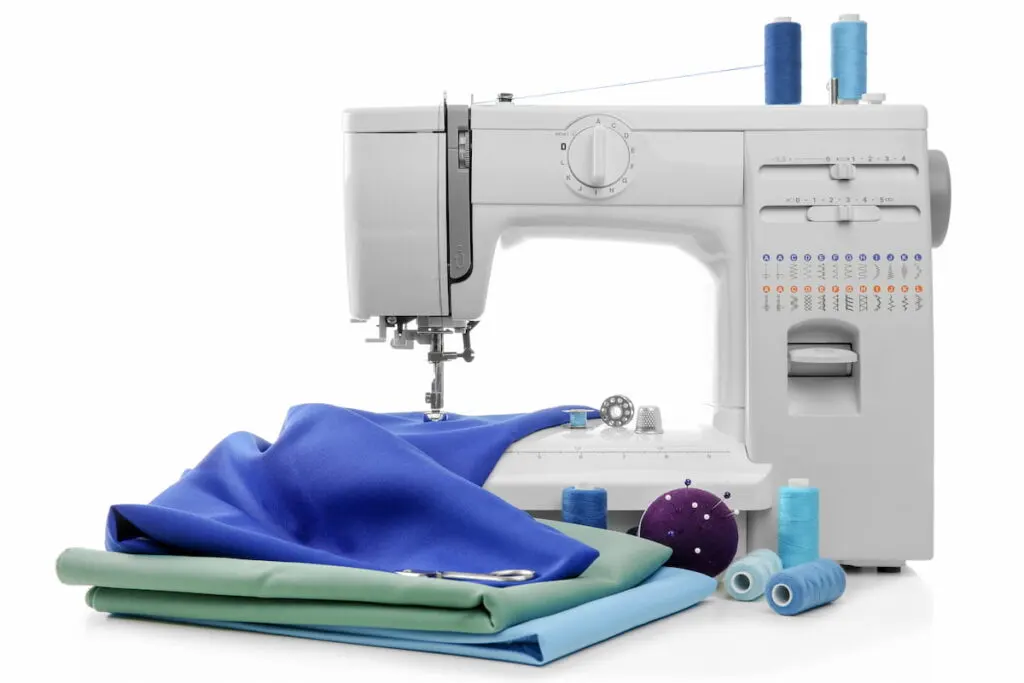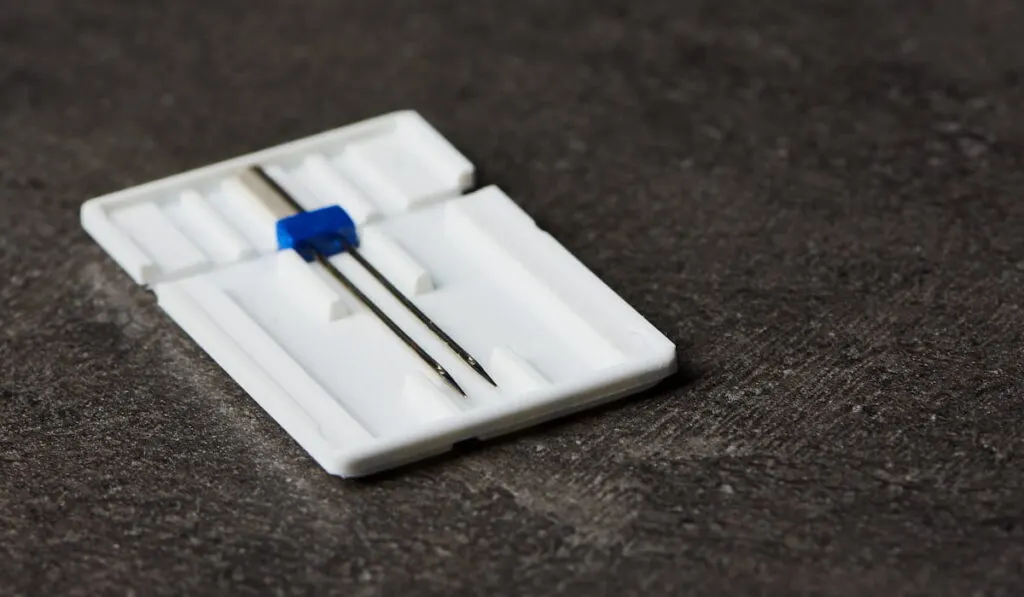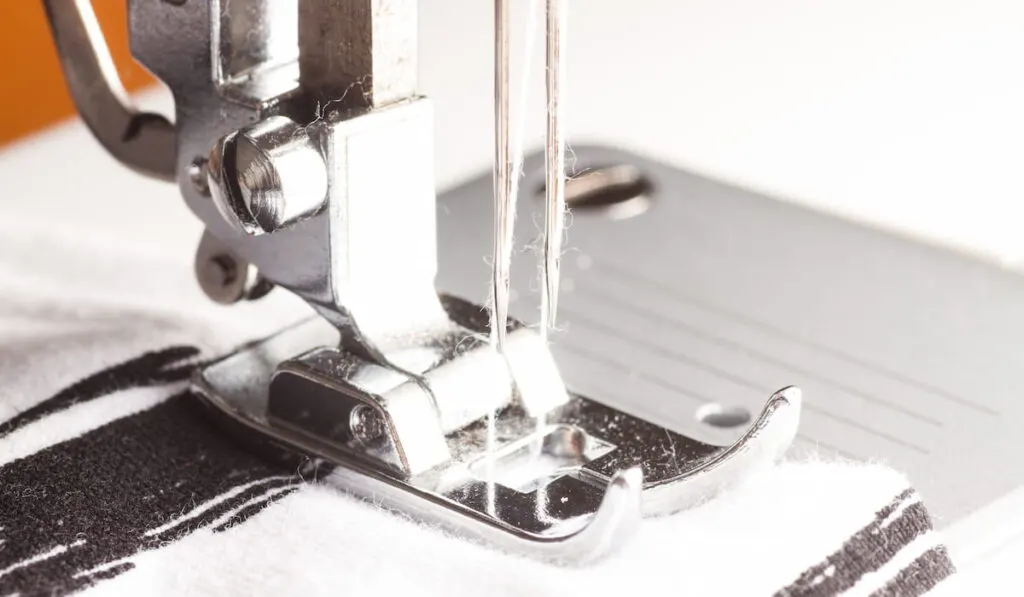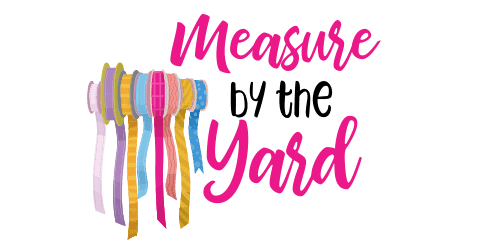Sewing is almost impossible without sewing needles. Commonly, sewing machines use a single needle to move thread between layers of fabric or other materials.
However, you’ll find that some sewing machines use twin needles. Twin needles are used to create special stitches that cannot be made with a single needle.

Wondering whether your sewing machine is compatible with twin needles? Let’s take a closer look at how twin needles work, how to identify a machine that uses twin needles, and how to choose the right type for your project.
What Is a Twin Needle?
A twin needle is simply a double needle connected to a single shank. They are made so that one needle is shorter than the other to allow for easy threading.
Just like the common single needles, twin needles are available in different sizes. The needles have two specific numbers assigned to them. One of the numbers shows the distance between the needles while the other denotes the length.
For example, if a twin needle comes with 5/70 inscribed on it, this means there is a 5mm space between the two needles of size 70.
But remember, there may be a limit to the needle width that your machine can handle. You should check your specific sewing machine manual for more information.
How to Know if Your Sewing Machine Can Take a Twin Needle
One way to confirm whether your machine can take a twin needle is to check the type of stitches it makes. If the sewing machine can make both a straight stitch and a zigzag stitch, then it can accommodate a twin needle.
If your sewing machine has a presser foot with an opening wide enough, it can also take a twin needle.
It is important to ensure that the zigzag needle plate of your machine is wide enough for your twin needle. You should also ensure that the stitch settings on the machine are on straight stitch.
Almost all modern sewing machines can use a twin needle. You should not need to purchase a fancy or expensive sewing machine to be able to stitch with a twin needle.
Sewing With a Twin Needle
You must ensure that the machine is in the straight stitch setting before you put in the twin needles. After inserting the twin needles, you may thread the machine.

Some machines have specific steps, so check your specific sewing machine manual before starting. In general, setting up your sewing machine with a twin needle is fairly straightforward.
- Placing the two thread spools on the thread pins of your machine.
- Thread the machine until you reach the needles.
- Thread one needle from one spool and then thread the other needle from the second spool.
- Set the machine to the single straight stitch setting.
- Loosen the tension of the top thread and begin sewing slowly.
- Place your hem facing the needles on the right side.
- Lower the presser foot and check the distance between the edge of the fabric and the place where you intend to stitch. This will ensure your stitches are close to the edge without going over it.
- Use the hand freewheel to make the first several stitches This is to ensure the needles do not collide with the foot and break.
Differences in Twin Needle vs. Single Needle Sewing
When you sew with a regular single needle, the hem is sewn on the wrong side of the fabric. However, when you are sewing with twin needles, the hem will be sewn on the right side of the fabric.
This might seem a bit unusual at first, but you will get used to it as you see the hem and decorative stitching take shape on your projects.
Projects That Require a Twin Needle
The following are some situations in which you should use a twin needle instead of a single needle:
- Making hems similar to cover stitch hems
- Sewing seams on sheer materials
- Attaching a ribbon trim
- Making decorative stitches
- Adding pintucks
- Creating parallel rows of topstitching
Types of Twin Needles
All twin needles are not the same. There are various types of twin needles, and each one is made for different types of fabrics.

Twin needles vary in different ways from needle thickness to the distance between needles, the color of the shank or crossbar, the shape of the needle tip, and the size of the needle eye.
Universal Twin Needles
Universal twin needles are general purpose needles. They are used on woven fabrics as well as stable knits. The tip of this needle is slightly rounded so it can slip through fabrics with ease.
Stretch Twin Needles
Stretch twin needles are used on stretchy fabrics. They are relatively thinner than regular needles. The tip of the stretch needle is more rounded and called a ballpoint.
With this rounded tip, the stretch twin needle does not pierce the fabric. Rather, it opens the fabric to the sides and enters the surface without damaging the fabric.
Embroidery Twin Needles
Embroidery twin needles are well known for their enlarged groove eye. This feature makes them best for decorative stitches.
Metallic Twin Needles
Metallic twin needles have enlarged coated eye and large groove shaft which prevent thread breaks.
Denim Twin Needles
Denim twin needles come with a sharp and strong needlepoint. These features allow them to penetrate very dense fabrics such as denim.
Double Hemstitch Twin Needles
Double hemstitch twin needles are specially made by Schmetz with one needle as a wing needle and the other as a regular needle. This needle is best used for decorative stitches on tightly woven fabrics.
Tips for Threading a Twin Needle
If you encounter difficulties while trying to thread a twin needle, follow these steps:
- Insert the shank of the twin needle in place of the regular needle on your sewing machine and screw in place.
- Change the presser foot to the zigzag foot since it has a wider slot for the needles to fit.
- Thread your bobbin the same way you normally do.
- Thread the needle on the left first, and proceed to thread the needle on the right.
- Some machines come with a space to place the second spool of thread. If yours does not come with one, you can improvise and create a spot for it by yourself.
Conclusion
Most modern sewing machines take twin needles, and your machine most likely takes them, too. Once you’ve double checked your instruction manual and thread your machine properly, using twin needles is pretty easy and can add a creative flair to your projects.
Resources
- https://sewguide.com/double-twin-needle-sewing/
- https://blog.treasurie.com/twin-needle-double-needle/
- https://www.ageberry.com/twin-needle-sewing-machine/
- https://www.heirloomcreations.net/can-i-use-a-double-needle/
- https://radianthomestudio.com/twin-needle-use/
- https://www.sewcanshe.com/blog/double-needle-sewing-machine
